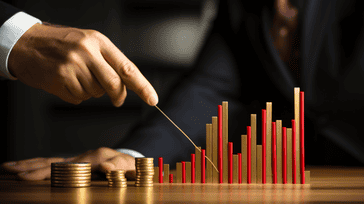The Importance of Business Investment as an Economic Indicator



Economic indicators play a crucial role in understanding the health of an economy. They provide valuable insights into economic performance, trends, and potential growth. One such economic indicator is business investment.
Business investment refers to money spent by companies on capital expenditures, research and development, and acquisitions. It serves as a reliable indicator of economic trends, as changes in business investment can indicate the overall health of the economy.
In this section, we will explore the critical role that business investment plays as an economic indicator. We will discuss how business investment impacts the overall economic performance and acts as a reliable indicator of economic trends.
Economic indicators are essential tools for analyzing and forecasting economic trends. They help economists and analysts understand the overall health of the economy, identify potential risks, and develop policies to support continued growth. Three types of economic indicators are leading indicators, lagging indicators, and financial indicators.
Leading indicators are economic data points that signal changes in the economy before they occur. These indicators can be used to anticipate future changes in business cycles. Some examples of leading indicators are stock prices, building permits, and consumer confidence.
Lagging indicators provide insights into changes in the economy that have already occurred. They confirm trends in the economy that have been established and help analysts confirm whether their predictions are accurate. Examples of lagging indicators include unemployment rates, consumer debt, and GDP growth.
Financial indicators reflect the financial health of businesses, governments, and individuals. These indicators can be used to determine potential economic growth, inflation rates, and changes in the value of currency. Some examples of financial indicators are interest rates, bond prices, and currency exchange rates.
Overall, understanding economic indicators is crucial for assessing the health of the economy. By analyzing leading, lagging, and financial indicators, economists and analysts can make informed predictions about economic performance and develop strategies to support continued growth and prosperity.

Business investment is a critical macroeconomic indicator that plays a significant role in driving economic growth. As such, it is vital to understand how businesses invest and the impact of their investments on the broader economy. As a macroeconomic indicator, business investment reflects the level of investment made by companies to expand their operations, develop new technologies, and increase productivity.
Macroeconomic indicators are economic measurements that help inform the state of the economy. These indicators include gross domestic product (GDP), unemployment rates, and inflation rates. Business investment is also one of the essential macroeconomic indicators that is closely monitored by policymakers and analysts to gauge the performance of an economy.
Economic growth, for instance, is often linked to the level of investment made by businesses. As such, policymakers use business investment data to make informed decisions that can stimulate economic growth and development. Understanding business investment and its impact on macroeconomic indicators is, therefore, crucial in analyzing and predicting economic trends.
Business investment is a crucial aspect of economic analysis, and understanding the various types of investments is essential for gaining valuable insights into economic trends. The following are the most common types of business investments:
| Investment Type | Description |
|---|---|
| Capital Expenditures | Investments in physical assets such as machinery, equipment, and buildings that are expected to generate returns over a long period. |
| Research and Development | Investments in developing or improving products, processes, or services that are expected to generate future revenue streams or cost savings. |
| Acquisitions | Investments in acquiring other businesses or assets that are expected to generate synergies or increase market share. |
These types of investments often have varying levels of risk and return, and analyzing them can provide unique insights into the state of the economy. For example, an increase in capital expenditures may indicate that businesses are confident in the economy's long-term outlook and are willing to invest in their future growth. On the other hand, a decrease in research and development investments may signal a lack of innovation or slowing growth in a particular industry.
Therefore, it's critical to examine each investment type in detail to gain a comprehensive understanding of the economy's current state and potential future trends.

The performance of the economy is closely tied to the level of business investment. In fact, changes in business investment often serve as a reliable indicator of economic trends and overall performance.
When businesses invest in new equipment, research and development, or acquisitions, it not only spurs economic growth but also creates jobs and contributes to consumer spending. On the other hand, a decrease in business investment can signal a weak economy and a potential downturn in the future.
Let's take a look at some real-life examples of the correlation between business investment and economic performance.
| Increase in Business Investment | Economic Performance |
|---|---|
| A company invests in new technology to increase production efficiency and boost profits. | The local economy experiences job growth, increased consumer spending, and overall economic expansion. |
| A city offers incentives for businesses to relocate, resulting in increased investment in the area. | The city experiences economic growth, higher employment rates, and a rise in property values. |
| Decrease in Business Investment | Economic Performance |
|---|---|
| A company cuts back on research and development due to a decrease in profits. | The company sees a decline in revenue and potential job loss, leading to decreased consumer spending and a weaker economy. |
| A country experiences a decrease in foreign investment due to political instability. | The country's economy suffers, resulting in a decrease in employment rates, decreased consumer spending, and potential recession. |
As the examples above demonstrate, the relationship between business investment and economic performance is a crucial one. By analyzing business investment data, it is possible to gain valuable insights into the overall state of the economy and predict future economic trends.
One of the significant impacts of business investment is job creation. As businesses invest more money in expansion and growth, they create new employment opportunities. This, in turn, helps to boost economic growth and productivity.
The relationship between business investment and job creation is best illustrated through empirical data. For example, in the United States, every $1 million invested in business capital expenditures leads to the creation of approximately seven new jobs. Furthermore, research and development expenditures have been found to have an even greater impact on job creation, with every $1 million invested resulting in 17 new jobs.
| Type of Business Investment | Number of Jobs Created per $1 Million Invested |
|---|---|
| Capital Expenditures | 7 jobs |
| Research and Development | 17 jobs |
It's important to note that the impact of business investment on job creation is not always immediate. In some cases, businesses may invest in projects that require significant preparation, planning, and construction before creating jobs. The job creation impact may be felt more in the long term than in the short term.
Overall, the relationship between business investment and job creation is critical in driving economic growth. As businesses invest more money, they create new opportunities for individuals to work and support themselves and their families.

One of the most significant impacts that business investment has on the economy is its effect on consumer spending. Increased investment leads to more jobs, which, in turn, increases consumer confidence and spending.
Consumer spending accounts for a significant portion of economic growth, making it a crucial factor in analyzing economic indicators. As businesses invest more, it creates a positive ripple effect throughout the economy. More jobs lead to more income, which leads to increased spending, and this cycle continues.
As consumer spending increases, it further stimulates economic growth and creates a positive environment for businesses to thrive. When businesses see an increase in demand for their products or services, they are more likely to invest further in their operations, creating a self-reinforcing cycle of growth.
Consumer confidence is an essential factor in driving consumer spending. As businesses increase their investment in the economy, it creates a sense of stability and security for consumers, which leads to more spending. On the other hand, a decline in business investment can lead to a decrease in consumer confidence, resulting in reduced spending.
The relationship between business investment and consumer confidence is closely linked to economic indicators. As businesses invest more, it signals a positive environment for growth, which is reflected in a rise in consumer confidence and spending. Similarly, a decline in investment can signify economic uncertainty, which can lead to a drop in consumer confidence and spending.
Economic indicators such as GDP, employment rates, and inflation provide valuable insights into consumer spending. These indicators help to assess the overall health of the economy and the consumer's buying power. By analyzing economic indicators, businesses can make informed decisions about investment and pricing strategies that can lead to increased consumer spending.
For instance, businesses may adjust their pricing strategy to align with consumer spending patterns. If economic indicators show a decline in consumer spending, businesses may introduce promotional pricing or discounts to attract consumers. Conversely, if economic indicators show a rise in consumer spending, businesses may increase their prices to maximize profitability.
Business investment plays a vital role in driving economic growth, and its impact on consumer spending is significant. As businesses invest more, it creates a positive cycle of growth, leading to increased consumer confidence and spending. By analyzing economic indicators, businesses can gain valuable insights into consumer spending patterns and make informed decisions that can drive growth and profitability.
Government policies have a significant influence on business investment, shaping economic performance and analysis. Fiscal and monetary policies are two major factors that impact investment decisions.
Fiscal policy refers to government spending and taxation. Governments often use fiscal policy to influence economic activity by increasing or decreasing government spending or taxes. In terms of business investment, fiscal policies can affect the demand for goods and services and, in turn, impact investment decisions.
For instance, tax incentives may encourage businesses to invest in new equipment and technology, leading to increased productivity and economic growth. Alternatively, increased taxes can lead to decreased consumer spending, which can negatively impact businesses and their investment decisions.
Monetary policy refers to the actions of a central bank to control the money supply and interest rates. Central banks adjust monetary policy to influence economic activity by changing the cost of borrowing money. For businesses, changes in interest rates can have a significant impact on investment decisions.
Lower interest rates can make borrowing less expensive, encouraging businesses to invest in new projects and expand their operations. Higher interest rates, on the other hand, can discourage investment, making it more expensive for businesses to access the capital they need to grow.
When analyzing economic performance, it is essential to consider the impact of government policies on business investment. A strong economy requires a healthy business sector, and government policies that encourage investment can lead to increased economic growth and performance.
However, government policies that discourage investment or create uncertainty can have a negative impact on the economy. Analyzing the interplay between business investment and government policies is crucial to understanding economic performance and predicting future trends.
"Government policies have a significant influence on business investment, shaping economic performance and analysis."
Business investment plays a crucial role in the global economy as it contributes significantly to economic indicators and growth. The impact of international investments on the economy can be seen through various economic indicators such as GDP, employment rates, and inflation.
Globalization has made it easier for businesses to invest in other countries, providing opportunities for growth and expansion. Foreign direct investment (FDI) is a key driver of economic growth and is a measure of business investment that is made by companies outside the country's borders. FDI contributes to economic growth by increasing the capital stock, creating jobs, and improving productivity.
The impact of FDI on the economy can be observed through its effect on economic indicators such as employment rates, exports, and imports. For example, FDI can lead to job creation in both the host and home countries. In addition to this, FDI can stimulate innovation and technology transfer, which can help to improve productivity.
| Country | Amount of FDI (in billions) |
|---|---|
| United States | 313.7 |
| China | 199.0 |
| Hong Kong | 104.3 |
| United Kingdom | 78.7 |
| Netherlands | 77.8 |
The table above shows the top five countries for FDI in 2020. As you can see, the United States received the highest amount of FDI, followed by China. FDI can provide a boost to the economy of the host country, leading to job creation and increased economic growth.
However, it is important to note that business investment can also have negative impacts on the global economy. For example, foreign companies investing in a country may not prioritize the well-being of the local population and may exploit resources or labor. Therefore, it is crucial to monitor and regulate international investments to ensure that they are beneficial for both the investors and the host country.
In conclusion, business investment is a crucial factor in the global economy. International investments contribute significantly to economic indicators and growth, but it is important to monitor and regulate them to ensure that they have a positive impact on the economy. By analyzing business investment data, we can gain valuable insights into the state of the global economy and make informed decisions about economic policies and investments.
When analyzing the state of the economy, it's essential to look at the data related to business investment. This data can provide valuable insights into economic trends and help predict future economic performance.
One way to analyze business investment data is to track the changes in economic data over time. This can be done by examining the growth rates of various economic indicators, such as GDP, industrial production, and employment rates.
Creating a table that compares business investment data to other economic data can also be helpful. Here's an example:
| Economic Indicator | 2018 | 2019 | 2020 |
|---|---|---|---|
| Gross Domestic Product (GDP) | $20 trillion | $21.4 trillion | $19.5 trillion |
| Industrial Production Index (IPI) | 101.5 | 104.3 | 95.9 |
| Employment Rate | 3.9% | 3.5% | 8.9% |
| Business Investment (BI) | $3.5 trillion | $3.8 trillion | $2.9 trillion |
In this example, we can see that while GDP and IPI both increased from 2018 to 2019, they decreased significantly in 2020. However, employment rates increased from 2018 to 2019 but then decreased sharply in 2020. Business investment also increased from 2018 to 2019 but decreased significantly in 2020. Through this comparison, we can see the impact that business investment has on other economic indicators.
Another method for analyzing business investment data is to look at economic trends over a more extended period. This helps identify patterns and cycles in economic performance. By analyzing these patterns, we can make informed predictions about future economic performance.
In conclusion, analyzing business investment data is crucial when examining economic trends and predicting future performance. By monitoring changes in economic data over time, comparing different economic indicators, and identifying patterns and cycles, we can gain valuable insights into the overall state of the economy.
In conclusion, business investment plays a vital role as an economic indicator. It is a reliable predictor of economic performance and holds significant implications for economic growth and development. By analyzing business investment data, policymakers and analysts can gain valuable insights into economic trends and patterns. It also helps them to make informed decisions to ensure economic stability and sustainability.
As we have seen, changes in business investment can impact economic indicators such as economic performance and economic trends. A rise in business investment can lead to increased job creation, boost consumer confidence, and drive economic growth. Similarly, a decline in investment can lead to a decrease in economic activity and growth.
Therefore, it is essential to consider business investment when analyzing economic performance and trends. By monitoring business investment data and understanding its impact on the economy, policymakers can develop effective strategies to promote economic growth and stability. It will also help individuals and business owners to make informed investment decisions, contributing to overall economic prosperity.
In short, business investment serves as a critical macroeconomic indicator that affects key aspects of the economy. Understanding its significance and analyzing its trends can lead to better economic outcomes for both businesses and individuals. Therefore, we must continue to consider business investment as we evaluate the state of the economy and seek to promote economic growth and stability.
Business investment plays a critical role as an economic indicator. It impacts overall economic performance and acts as a reliable indicator of economic trends.
Economic indicators are measures used to analyze and predict economic trends. They include leading indicators, lagging indicators, and financial indicators.
Business investment refers to the spending on capital goods by businesses. It contributes to overall economic growth and development and is considered a macroeconomic indicator.
Business investments can include capital expenditures, research and development, and acquisitions. Analyzing these investments is crucial for economic analysis.
Changes in business investment can indicate the health of the economy. Increases in investment often reflect positive economic performance.
Business investment plays a significant role in job creation. Increased investment leads to employment opportunities and drives economic growth.
Business investment stimulates consumer spending by boosting consumer confidence. Increased investment often leads to economic growth.
Government policies, such as fiscal and monetary policies, can impact investment decisions. These policies shape economic performance and affect business investment.
International investments affect economic indicators and contribute to global economic growth. Business investment plays a crucial role in the interconnectedness of the global economy.
Analyzing business investment data involves monitoring trends and patterns to gain valuable insights about the overall state of the economy and economic trends.
The article emphasizes the significance of considering business investment when analyzing economic performance and trends. It highlights the need to recognize business investment as a vital economic indicator.